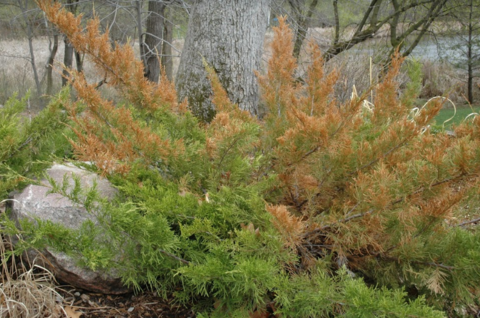Talking Plants
Jillian Patrie | University of Minnesota Yard and Garden Extension
Winter burned or bleached out evergreens are a common sight when spring comes around each year. What steps can be taken in the fall to prevent this kind of damage? Let’s explore a few methods gardeners can apply when prepping evergreens for winter.
Snow, lack of snow and dry conditions going into winter are all factors that can cause damage to evergreens. Winter sun, wind and cold temperatures can bleach and dry out evergreens. Root injury during the winter months is most common when soil is dry and there is no or little snow cover. Moist soils hold more heat, snow cover acts as insulation and cracks in the soil around newly planted trees can allow cold air to penetrate, killing newly formed roots. We can’t control the weather or how much snow falls each winter, but there are ways to prevent winter damage from occurring.
Mulching newly planted trees keeps moisture in and covers new roots. If the fall season has been dry, watering new trees until the ground freezes can reduce frost damage. Winter sun and wind can cause leaves to lose water, and in turn evergreens dry out and turn brown. Winter sun can be warm at times and can reactivate evergreen leaves. When the sun goes away, leaf temperatures drop, causing injury.
Arborvitae and Yew are most vulnerable and should be planted in protected areas or make a barrier with other branches or burlap. When using burlap place it on the windward side, leave the burlap barrier open at the top to let air and light in. Burlap does not need to be tightly wrapped around the plants, leave some space for air movement. Most importantly keep evergreens appropriately watered and cared for throughout the growing season.
Arborvitae are a nice treat for deer and rabbits come winter, protection from animal damage is also important when preparing evergreens for winter. If deer or rabbit are frequent visitors, place a physical barrier around trees or shrubs. Fencing is the best way to keep deer and rabbit out, but repellents will work as well if rotated between a few different products to keep them guessing.
For more information on protecting trees and shrubs for winter or evergreen winter burn solutions visit: https://extension.umn.edu/planting-and-growing-guides/protecting-trees-and-shrubs-winter
For more questions about this article or local assistance please contact Clay County Extension Educator Jill Patrie at 218-299-7338 or by email at patri350@umn.edu.


